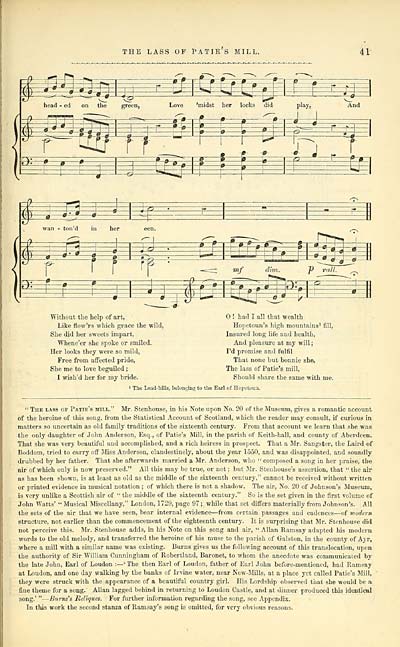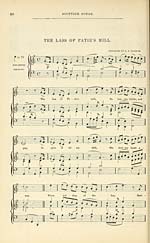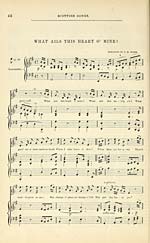Glen Collection of printed music > Printed music > Songs of Scotland > Volume 2
(49) Page 41
Download files
Complete book:
Individual page:
Thumbnail gallery: Grid view | List view

THE LASS OP PATIE S MILL.
41
Without the help of art,
Like iiow'rs "which grace the wild,
She did her sweets impart,
Whene'er she spoke or smiled.
Her looks they were so mild.
Free from affected pride.
She me to love beguiled ;
I wish'd her for my bride.
! had I all that wealth
Hopetoun's high mountains' fill.
Insured long life and health,
And pleasure at my will ;
I'd promise and fulfil
That none but bonnie she.
The lass of Patie's mill.
Should share the same with me.
' The Lead-hills, belonging to the Earl of Hopctoun.
" The l.^ss of Patie's mill." Mr. Stenhouse, in his Note upon No. 20 of the Museum, gives a romantic account
of the heroine of this song, irom the Statistical Account of Scotland, which the reader may consult, if curious in
matters so uncertain as old family traditions of the sixteenth century. From that account we learn that she was
the only daughter of John Anderson, Esq., of Patie's Mill, in the parish of Keith-hall, and county of Aberdeen.
That she was very beautiful and accomplished, and a rich heiress in prospect. That a Mr. Sangster, the Laird of
Boddom, tried to carry off Jliss Anderson, clandestinely, about the year 1550, and was disappointed, and soundly
drubbed by her father. That she afterwards married a Mr. Anderson, who " composed a song in her praise, the
air of which only is now preserved." All this may be true, or not ; but Jlr. Stenhouse's assertion, that " the air
as has been shown, is at least as old as the middle of the sixteenth century," cannot be received without written
or printed evidence in musical notation ; of which there is not a shadow. The air, No. 20 of Johnson's Museum,
is very unlike a Scottish air of " the middle of the sixteenth century." So is the set given in the first volume of
John Watts' " Musical Miscellany," London, 1729, page 97 ; while that set differs materially from Johnson's. All
the sets of the air that we have seen, bear internal evidence — ft-om certain passages and cadences — of modern
structure, not earlier than the commencement of the eighteenth century. It is surprising that Mr. Stenhouse did
not perceive this. Mr. Stenhouse adds, in his Note on this song and air, " Allan Ramsay adapted his modern
words to the old melody, and transferred the heroine of his muse to the parish of Galston, in the county of Ayr,
where a mill with a similar name was existing. Burns gives us the following account of this translocation, upon
the authority of Sir William Cunningham of Robertland, Baronet, to whom the anecdote was communicated by
the late John, Earl of Loudon : — ' The then Earl of Loudon, father of Earl John before-mentioned, had Ramsay
at Loudon, and one day walking by the banks of Irvine water, near New-Mills, at a place yet called Patie's Mill, '
they were struck with the appearance of a beautiful country girl. His Lordship observed tiiat she would be a
fine theme for a song. Allan lagged behind in returning to Loudon Castle, and at dinner produced this identical
song.' " — Burns's Beliques. For further information regarding the .Song, see Appendix.
In this work the second stanza of Ramsay's song is omitted, for very obvious reasons.
41
Without the help of art,
Like iiow'rs "which grace the wild,
She did her sweets impart,
Whene'er she spoke or smiled.
Her looks they were so mild.
Free from affected pride.
She me to love beguiled ;
I wish'd her for my bride.
! had I all that wealth
Hopetoun's high mountains' fill.
Insured long life and health,
And pleasure at my will ;
I'd promise and fulfil
That none but bonnie she.
The lass of Patie's mill.
Should share the same with me.
' The Lead-hills, belonging to the Earl of Hopctoun.
" The l.^ss of Patie's mill." Mr. Stenhouse, in his Note upon No. 20 of the Museum, gives a romantic account
of the heroine of this song, irom the Statistical Account of Scotland, which the reader may consult, if curious in
matters so uncertain as old family traditions of the sixteenth century. From that account we learn that she was
the only daughter of John Anderson, Esq., of Patie's Mill, in the parish of Keith-hall, and county of Aberdeen.
That she was very beautiful and accomplished, and a rich heiress in prospect. That a Mr. Sangster, the Laird of
Boddom, tried to carry off Jliss Anderson, clandestinely, about the year 1550, and was disappointed, and soundly
drubbed by her father. That she afterwards married a Mr. Anderson, who " composed a song in her praise, the
air of which only is now preserved." All this may be true, or not ; but Jlr. Stenhouse's assertion, that " the air
as has been shown, is at least as old as the middle of the sixteenth century," cannot be received without written
or printed evidence in musical notation ; of which there is not a shadow. The air, No. 20 of Johnson's Museum,
is very unlike a Scottish air of " the middle of the sixteenth century." So is the set given in the first volume of
John Watts' " Musical Miscellany," London, 1729, page 97 ; while that set differs materially from Johnson's. All
the sets of the air that we have seen, bear internal evidence — ft-om certain passages and cadences — of modern
structure, not earlier than the commencement of the eighteenth century. It is surprising that Mr. Stenhouse did
not perceive this. Mr. Stenhouse adds, in his Note on this song and air, " Allan Ramsay adapted his modern
words to the old melody, and transferred the heroine of his muse to the parish of Galston, in the county of Ayr,
where a mill with a similar name was existing. Burns gives us the following account of this translocation, upon
the authority of Sir William Cunningham of Robertland, Baronet, to whom the anecdote was communicated by
the late John, Earl of Loudon : — ' The then Earl of Loudon, father of Earl John before-mentioned, had Ramsay
at Loudon, and one day walking by the banks of Irvine water, near New-Mills, at a place yet called Patie's Mill, '
they were struck with the appearance of a beautiful country girl. His Lordship observed tiiat she would be a
fine theme for a song. Allan lagged behind in returning to Loudon Castle, and at dinner produced this identical
song.' " — Burns's Beliques. For further information regarding the .Song, see Appendix.
In this work the second stanza of Ramsay's song is omitted, for very obvious reasons.
Set display mode to: Large image | Transcription
Images and transcriptions on this page, including medium image downloads, may be used under the Creative Commons Attribution 4.0 International Licence unless otherwise stated. ![]()
| Special collections of printed music > Glen Collection of printed music > Printed music > Songs of Scotland > Volume 2 > (49) Page 41 |
|---|
| Permanent URL | https://digital.nls.uk/91335753 |
|---|
| Shelfmark | Glen.214a |
|---|---|
| Additional NLS resources: | |
| Attribution and copyright: |
|
| Description | Scottish songs and music of the 18th and early 19th centuries, including music for the Highland bagpipe. These are selected items from the collection of John Glen (1833 to 1904). Also includes a few manuscripts, some treatises, and other books on the subject. |
|---|
| Description | The Glen Collection and the Inglis Collection represent mainly 18th and 19th century Scottish music, including Scottish songs. The collections of Berlioz and Verdi collected by bibliographer Cecil Hopkinson contain contemporary and later editions of the works of the two composers Berlioz and Verdi. |
|---|

